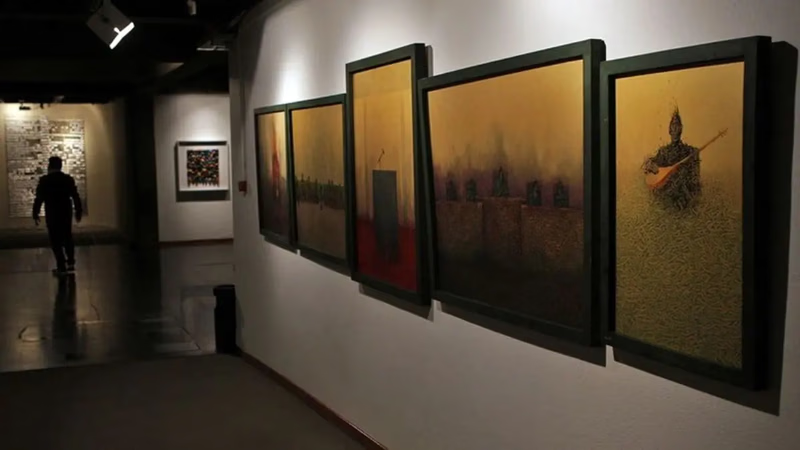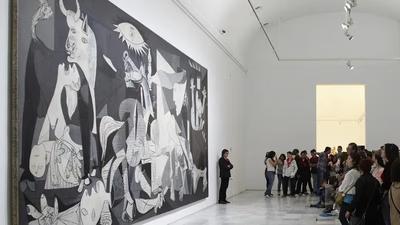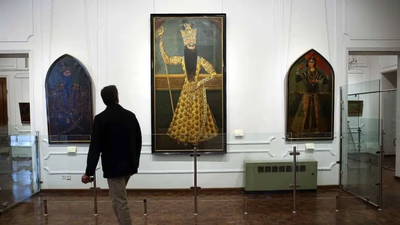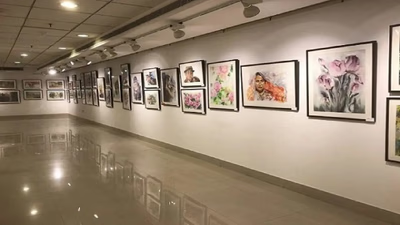
Explore major painting galleries and auctions in West Asia.
Art exhibition centers are known as a reference for collecting and supplying artworks to the market. Here, attention is paid to criteria such as reputation, volume of work, value of artworks, prominent suppliers and history of artistic activities. Auctions are events where works of art are put up for public auction and organized by auctioneers. At these events, artworks are auctioned off and sold to interested buyers. Auctions are usually held in large and important art cities and can be the center of commercial exchange and major art contracts.
Some of the largest and most famous art galleries in the Middle East are :
- Dubai National Art Gallery, United Arab Emirates : This gallery is one of the largest and most important art galleries in the region and displays a collection of contemporary and classical works of art.
- Tehran Museum of Contemporary Art, Iran: This large museum is located in Tehran and contains more than 7,000 works of contemporary Iranian and international art.
- Doha Museum of Contemporary Art, Qatar: This museum is located in Qatar and displays a collection of international contemporary art.
- Arab Contemporary Art Museum, United Arab Emirates: Located in Abu Dhabi, this museum houses the largest collection of modern and contemporary Arabic art.
- Istanbul Museum of Contemporary Art, Turkey: Located in Istanbul, this museum exhibits the works of prominent local and international painters.
- Louvre Abu Dhabi, United Arab Emirates: This museum is located in Abu Dhabi and houses a collection of classical and contemporary international art.
The most important and largest markets for buying and selling artworks in the Middle East and West Asia are:
- Tehran Art Bazaar is one of the largest and most prestigious markets for buying and selling works of art in Iran . This market is held in Tehran and sells the works of contemporary Iranian artists.
- Aftab area in Dubai is one of the most important art centers and art markets in the Middle East. This area includes galleries, auctions and art centers.
- King Fahd Center for Culture and Arts, Riyadh, has large art markets in its features. It hosts various exhibitions, auctions and artistic activities.
- Istanbul Art Auction is one of the most famous art auctions in Turkey . In this auction, various works of art from contemporary and classical painters are sold.
- Art Route in Beirut, Lebanon is one of the most important art markets in the region. This art market includes galleries, exhibitions and auctions and showcases the works of local and international artists.
Some of the most expensive paintings in the Middle East are:
- "Crocodile" by Xavier Camelot: This painting was sold at a 2010 Satoby auction in Dubai for $2.5 million.
- "Board" by Parviz Tasfazi: This painting was sold at Christie's auction in Dubai for 2.8 million dollars in 2008.
- "Repetition" by Mohammad Ibrahim Jaffrey: This painting was sold in 2008 at a Satobi auction in London for $1.5 million.
- "Mapping" by Parviz Kabuli: This painting was sold at Christie's Dubai in 2007 for $1.2 million.
Galleries are places where works of art are displayed and contracted for sale to enthusiasts and collectors. Galleries are usually a place to display and review works of art, introduce artists, hold exhibitions and interact with the art community. Artworks are displayed in galleries permanently or in the form of temporary exhibitions. Considering the spatial and semantic differences between auctions and galleries, referring to the most important auctions and the largest painting galleries in West Asia means their prominence and important role in the art industry and art market.
-

The Middle East has a rich cultural heritage in art and painting, with a strong interest in buying and selling artworks. This region values painting not only for its aesthetic appeal but also for its cultural and religious significance. Various platforms such as art exhibitions, auctions, and galleries facilitate the trade of artworks, with notable markets like the Tehran Art Market in Iran. While the level of interest in art transactions may vary due to economic conditions and individual tastes, the Middle East remains a significant player in the global art scene. Museums across the region house masterpieces from renowned artists like Francis Bacon, Vincent Van Gogh, and Leonardo da Vinci, attracting collectors and investors alike. Wealthy individuals in countries such as the UAE, Qatar, and Saudi Arabia view art as a viable investment opportunity. The market is also receptive to contemporary works, with numerous events showcasing emerging artists. Overall, the Middle East is recognized as a vibrant marketplace for both classical and modern art.
-

Islamic art in West Asia showcases a rich tapestry of styles influenced by cultural and religious elements. Characterized by geometric patterns, calligraphy, and vibrant colors, it includes Persian miniature paintings that depict intricate scenes from literature and history. The Qajar dynasty significantly impacted regional art with opulent portrayals of court life. Various painting styles exist, such as landscape, religious, carving, and mystical paintings, each reflecting the region"s diverse heritage. Miniature paintings are particularly notable for their detailed depictions of fictional narratives. In mosques and shrines, complex geometric designs and calligraphic art enhance the spiritual ambiance. Contemporary artists in West Asia continue to innovate, addressing social and political themes through diverse mediums. This blend of traditional and modern influences highlights the ongoing evolution of Middle Eastern art. "
-

Art exhibition centers in West Asia serve as key venues for collecting and supplying artworks, focusing on reputation, volume, and value. Auctions play a significant role in the art market, facilitating public sales of artworks in major cities. Notable galleries include the Dubai National Art Gallery, Tehran Museum of Contemporary Art, and Doha Museum of Contemporary Art, each showcasing a diverse range of contemporary and classical art. The Tehran Art Bazaar and Aftab area in Dubai are prominent markets for buying and selling art, hosting various exhibitions and auctions. The King Fahd Center for Culture and Arts in Riyadh and Istanbul Art Auction are also vital to the region"s art scene. Some of the most expensive paintings sold include "Crocodile" by Xavier Camelot and "Board" by Parviz Tasfazi, highlighting the high-value transactions occurring within these markets. Overall, these galleries and auctions underscore their importance in shaping the art industry in West Asia. "
-

The export value of painting artworks is influenced by various factors, including the artist"s reputation, artistic style, historical significance, and market demand. Renowned artists like Leonardo da Vinci and Vincent van Gogh command high prices due to their cultural impact. Contemporary artists such as Andy Warhol also have significant export value. Unique styles, such as impressionism and hyperrealism, enhance marketability. Participation in art fairs and exhibitions provides opportunities for artists to connect with buyers and collectors. Online platforms are increasingly important for reaching wider audiences. Compliance with export laws is crucial; this includes obtaining necessary permits and understanding local regulations. Strong packaging and reliable transportation methods are essential to prevent damage during transit.
Effective marketing strategies, including social media engagement and email communication, help maintain customer relationships. Researching target markets is vital for identifying demand and competitive products. Innovative artworks can achieve higher export values. "




